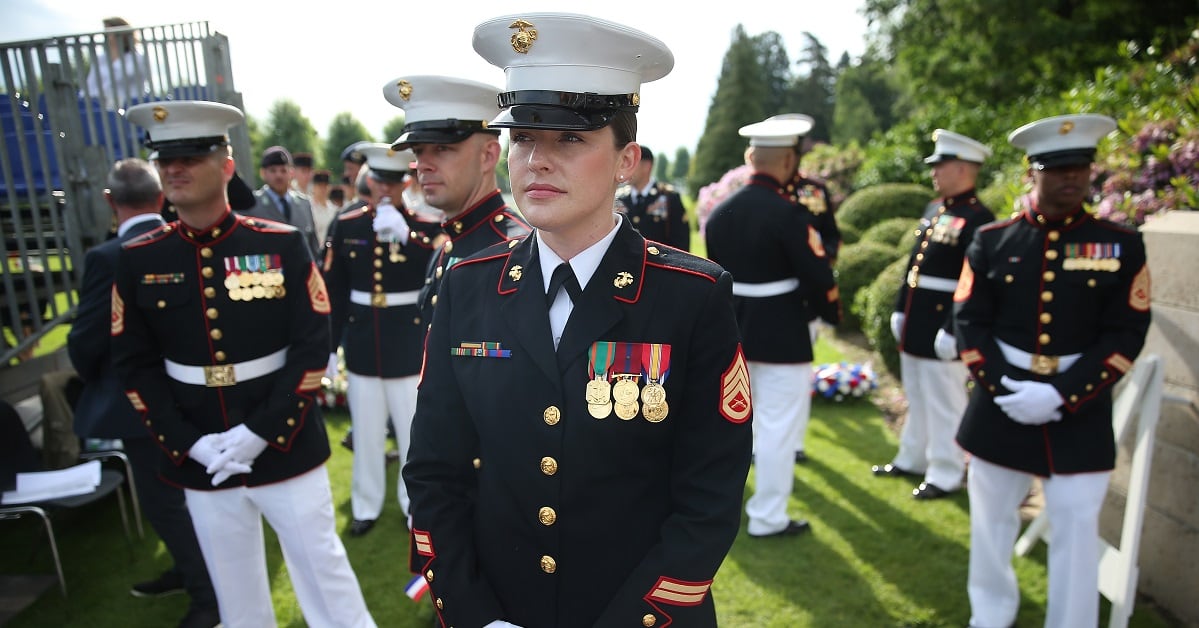The Marine Corps has pushed back the mandatory wear date for the new female dress blue coat and is coming up short on a handful of other items as the service experiences supply chain issues in the wake of the COVID-19 pandemic.
Now female Marines are not required to own the new version of the dress blue coat until April 1, 2023 ― nearly five years after it was first issued to Marines. That’s due to shortages that also are affecting the running suit, the combat blouse, the men’s long and short-sleeved khaki shirt and the all-weather coat, Maj. James Stenger told Marine Corps Times.
“We are working to quickly and efficiently address any supply chain issues,” Stenger said in a statement. “Each uniform comes with its own unique challenges as far as sourcing is concerned.”
Marines who don’t get a uniform item as part of their initial uniform issue will get it at the unit they’re headed to, Stenger said. He said the “gaining commands” of Marines who’d been shorted any items would be notified of what they were owed so it could be made available to them.
RELATED

“In other instances, we already have mitigation measures in place so Marines at the end of the supply chain won’t be negatively affected in any way,” he said.
Marine recruits are measured for dress and service uniform items about four weeks into boot camp training. Their “phase 2″ uniform issue includes the all-weather coat, service coat and dress blue coat. It also includes two green pairs of service slacks and one blue pair; a service sweater; dress shoes; the olive green running suit; two long- and three short-sleeved khaki shirts; and the relevant military covers and accessories.
Marine Corps officers, who receive an initial clothing allowance of about $2,200 and a biennial replacement allowance instead of a sea bag of issued items, are on their own for sourcing any hard-to-find items they need, as are enlisted Marines shopping for replacements.
Stenger said the service expects resolution within weeks or months for most of the items.
For the combat utility blouse, “we anticipate the vendor to be shipping thousands more coats from its facility this month, which should alleviate some of the supply chain issues for that item,” he said. “In the case of the men’s khaki shirts, we anticipate the issue to be fully resolved over the next few months. The same applies for the all weather coat. We appreciate all of our partners in the supply chain working with us on timely, effective solutions.”
The service announced the timeline change for the new female dress blue coat in an October administrative message.
The coat, which began development in 2013, was first issued to Marines at boot camp in 2018. It features a high mandarin collar, like that on the men’s dress blue coat, in place of an open, suit-style collar with a white shirt underneath.
While the service announced the Oct. 1 mandatory wear date soon after that, it did issue modified guidance in 2020, saying that women who planned to leave the service before Jan. 1, 2023, could opt out of buying the pricey new item. The coat retails for about $230, and the unisex look has proved off-putting for some Marines, who have spoken out in defense of the legacy coat.
Supply issues with the coat had emerged in mid-September, said Capt. Danielle Phillips, a spokeswoman for Marine Corps Training and Education Command.
“Fleet feedback to Training and Education Command indicated a lack of Female Dress Blue Coast in stock,” she said in a statement. “This was likely a result of low inventory at the time of ordering and issues in production during COVID to phase the appropriate number of coats.”
The postponed possession date was expected to give Marines “ample time” to get the coat based on stock estimates from the Defense Logistics Agency, she said. No further delays are expected.
The Marine Corps is not the only service to experience shortages in the wake of the pandemic. While the Berry Amendment generally requires military uniform items to be wholly produced in the U.S., global supply chain disruptions due to changes in demand during and following the COVID-19 pandemic have affected domestic suppliers as well as international ones.
In 2021, Stars and Stripes reported that the Air Force was issuing fewer uniform shirts and trousers to new airmen at the end of Basic Military Training due to shortages. The Coast Guard also was forced to switch suppliers in 2020 because of insufficient stocks.
Hope Hodge Seck is an award-winning investigative and enterprise reporter covering the U.S. military and national defense. The former managing editor of Military.com, her work has also appeared in the Washington Post, Politico Magazine, USA Today and Popular Mechanics.




